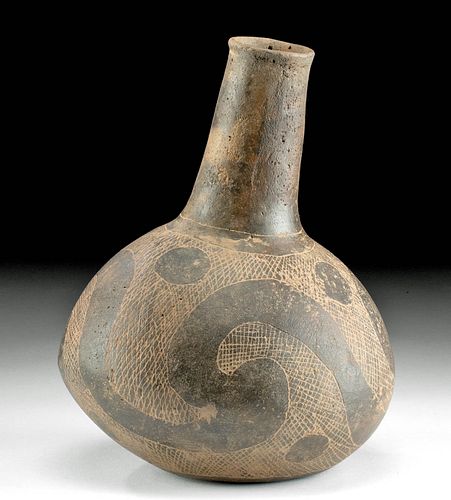Mississippian Caddo Hodges Engraved Pottery Jar, TL'd
Lot 220a
About Seller
Artemis Gallery
686 S Taylor Ave, Ste 106
Louisville, CO 80027
United States
Selling antiquities, ancient and ethnographic art online since 1993, Artemis Gallery specializes in Classical Antiquities (Egyptian, Greek, Roman, Near Eastern), Asian, Pre-Columbian, African / Tribal / Oceanographic art. Our extensive inventory includes pottery, stone, metal, wood, glass and textil...Read more
Categories
Estimate:
$2,400 - $3,600
Absentee vs Live bid
Two ways to bid:
- Leave a max absentee bid and the platform will bid on your behalf up to your maximum bid during the live auction.
- Bid live during the auction and your bids will be submitted real-time to the auctioneer.
Bid Increments
| Price | Bid Increment |
|---|---|
| $0 | $25 |
| $300 | $50 |
| $1,000 | $100 |
| $2,000 | $250 |
| $5,000 | $500 |
| $10,000 | $1,000 |
| $20,000 | $2,500 |
| $50,000 | $5,000 |
| $100,000 | $10,000 |
| $200,000 | $20,000 |
About Auction
By Artemis Gallery
Mar 24, 2022
Set Reminder
2022-03-24 10:00:00
2022-03-24 10:00:00
America/New_York
Bidsquare
Bidsquare : Exceptional Antiquities Ethnographic Fine Art
https://www.bidsquare.com/auctions/artemis-gallery/exceptional-antiquities-ethnographic-fine-art-9057
Museum-worthy examples of classical antiquities (Egyptian, Greek, Roman, Near Eastern), Viking, Far East / Asian, Pre-Columbian, African / Tribal, Oceanic, Native American, Spanish Colonial, Fossils, Ancient Jewelry, Fine / Visual Arts, so much more! Artemis Gallery info@artemisgallery.com
Museum-worthy examples of classical antiquities (Egyptian, Greek, Roman, Near Eastern), Viking, Far East / Asian, Pre-Columbian, African / Tribal, Oceanic, Native American, Spanish Colonial, Fossils, Ancient Jewelry, Fine / Visual Arts, so much more! Artemis Gallery info@artemisgallery.com
- Lot Description
Native American, Southeast or Midwest, Caddo / Mississippian, ca. 770 to 1270 CE. A fabulous pottery jar presenting a bulbous body, a sloped shoulder, and a narrow, conical neck that stretches up to a flared rim, all sitting upon a flat base. Boasting a smoky black surface, the ancient vessel has been skillfully incised using the Hodges Engraved method along its exterior body. This decorative program is comprised of a lattice motif field with an undulating, serpentine motif that wraps horizontally around the body of the vessel - perhaps representing winds, seasons, or the spinning motion of the cosmos - with 4 circular motifs above and another 4 below, possibly symbolizing the 4 cardinal directions. A singular horizontal striation encircles the base of the neck. Size: 6.6" Diameter x 8.4" H (16.8 cm x 21.3 cm)
Caddoan pottery was the finest produced by the Mississippian culture, with very thin walls, intricate motifs, and well-proportioned shapes. These ceramics are largely considered the apex of the art of the Southeast. According to the Sam Noble Museum (Oklahoma's Museum of Natural History), "We will never fully understand the underlying social and spiritual significance of the meanings intertwined within the designs of Caddo pottery. This knowledge was passed down orally and was not recorded by early European explorers, so it has since been partially lost through attempts by the United States government in the 19th and 20th centuries to overwhelm and assimilate the Caddo people. Caddo people began an earlier rapid change after their first contacts with Spanish colonists in the 1500s. Smallpox, measles, cholera and other European diseases ravaged the Caddo and reduced their population by 95 percent before 1700. Archaeological evidence reveals larger villages along the Arkansas, Red, and Ouachita rivers were abandoned and a change from burial of elites only in mounds to community mortuaries during this time period."
Cf. Detroit Institute of Arts, 1991.120 and Minneapolis Institute of Art, 89.17.
This piece has been tested using thermoluminescence (TL) analysis and has been found to be ancient and of the period stated.
Provenance: Private Hidden Valley Lake, California, USA collection
All items legal to buy/sell under U.S. Statute covering cultural patrimony Code 2600, CHAPTER 14, and are guaranteed to be as described or your money back.
A Certificate of Authenticity will accompany all winning bids.
PLEASE NOTE: Due to recent increases of shipments being seized by Australian & German customs (even for items with pre-UNESCO provenance), we will no longer ship most antiquities and ancient Chinese art to Australia & Germany. For categories of items that are acceptable to ship to Australia or Germany, please contact us directly or work with your local customs brokerage firm.
Display stands not described as included/custom in the item description are for photography purposes only and will not be included with the item upon shipping.
#170491Expected nicks, abrasions, pitting, and scratches throughout, commensurate with age. Otherwise, intact and excellent with impressive preservation of incised detail. TL holes to interior of rim and base.Condition
- Shipping Info
-
All shipping is handled in-house for your convenience. Your invoice from Artemis Gallery will include shipping calculation instructions. If in doubt, please inquire BEFORE bidding for estimated shipping costs for individual items.
-
- Buyer's Premium



 EUR
EUR CAD
CAD AUD
AUD GBP
GBP MXN
MXN HKD
HKD CNY
CNY MYR
MYR SEK
SEK SGD
SGD CHF
CHF THB
THB














